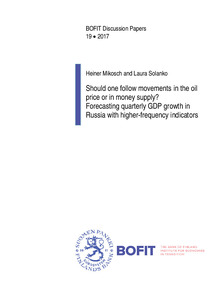Should one follow movements in the oil price or in money supply? Forecasting quarterly GDP growth in Russia with higher-frequency indicators
Mikosch, Heiner; Solanko, Laura (30.11.2017)
Numero
19/2017Julkaisija
Bank of Finland
2017
Julkaisun pysyvä osoite on
https://urn.fi/URN:NBN:fi:bof-201712111680Tiivistelmä
GDP forecasters face tough choices over which leading indicators to follow and which forecasting models to use. To help resolve these issues, we examine a range of monthly indicators to forecast quarterly GDP growth in a major emerging economy, Russia. Numerous useful indicators are identified and forecast pooling of three model classes (bridge models, MIDAS models and unrestricted mixed-frequency models) are shown to outperform simple benchmark models. We further separately examine forecast accuracy of each of the three model classes. Our results show that differences in performance of model classes are generally small, but for the period covering the Great Recession unrestricted mixed-frequency models and MIDAS models clearly outperform bridge models. Notably, the sets of top-performing indicators differ for our two subsample observation periods (2008Q1–2011Q4 and 2012Q1–2016Q4). The best indicators in the first period are traditional real-sector variables, while those in the second period consist largely of monetary, banking sector and financial market variables. This finding supports the notion that highly volatile periods of recession and subsequent recovery are driven by forces other than those that prevail in more normal times. The results further suggest that the driving forces of the Russian economy have changed since the global financial crisis.
Julkaisuhuomautus
Published in Russian Journal of Money and Finance, Volume 78, Number 1, March 2019
